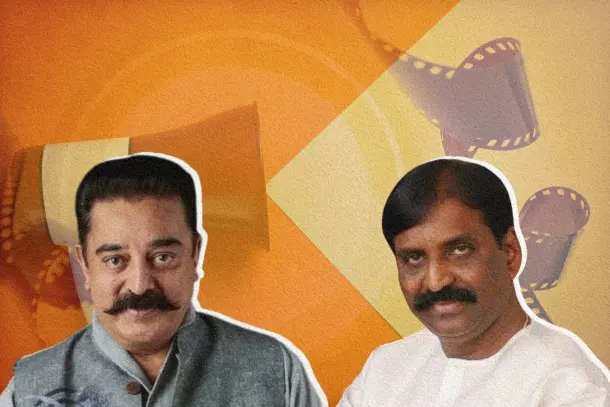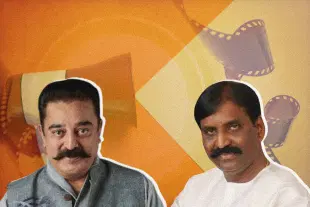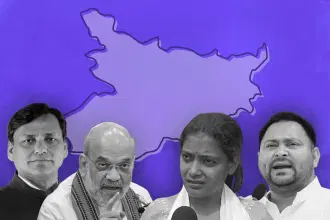Tamil Nadu
Celluloid Daggers: A Calculated Assault On Hinduism By Kollywood's Dravidian Voices
K Balakumar
Aug 14, 2025, 01:00 PM | Updated 01:00 PM IST
Save & read from anywhere!
Bookmark stories for easy access on any device or the Swarajya app.


In Tamil Nadu, the so-called Dravidian intellectual climate has long been notorious for harbouring hostility towards Hindu traditions. But recent weeks have seen that malevolence crystallise into something sharper. It now seems a full-blown orchestrated campaign, fronted not by politicians in white shirts but by film industry personalities who owe their current relevance, or survival, to the ruling Dravidian establishment.
Take the case of Kamal Haasan's recent utterance. The setting was a benign one. A felicitation function of a private educational trust. There was no ostensible reason to invoke Sanatana Dharma. Yet Kamal, the newly anointed Member of Parliament courtesy of Dravidian political largesse, chose the occasion to launch into an attack on it. It was not a nuanced critique, but a broad, public, and aggressive denigration of the core tenet of Hinduism.
The intervention had no contextual justification. It was calculated theatre, and Kamal knew the sparks it would set off. The message was clear: this was not about art or debate, but about paying tribute to his political patrons. A signal of allegiance. A performance, not of art, but of ideological servitude.
From screen god to sanctimonious blusterer, his fall has been the most precipitous.
Vairamuthu’s targeted provocation
At another event elsewhere, lyricist Vairamuthu reached for the Kamba Ramayana, citing a famed line by the character Vaali that questions Lord Ram’s conduct. Vairamuthu’s gloss on Kambar’s verse equated Ram’s state of mind after losing Sita to a form of insanity, even invoking the Indian Penal Code to suggest Ram was “an accused who was acquitted, thanks to Kambar's ennobling lines”.
The problem was not the mere act of literary interpretation, an art form in itself, but the context. The dais was shared by Dravidian heavyweights, including Chief Minister MK Stalin, and the political undertone was unmistakable. Given the Dravidian movement’s long history of deriding the Ramayana, even turning it into a cheesy farce in their infamous Keemayanam, any claim of detached scholarship rings hollow.
A butcher sermonising on compassion would invite scepticism; likewise, the Dravidian Vairamuthu’s literary parsing cannot be separated from his ideological baggage, particularly after his past disparagement of revered figures like Andal.
Hypocrisy masquerading as aesthetics
In the same function, when Stalin claimed that the Dravidian movement merely views the Kamba Ramayana “from a different perspective”, he glossed over decades of the movement’s openly philistine treatment of both Lord Ram and the epic. The selective embrace of Kambar’s work now is not a mark of maturity, but just opportunistic appropriation.
Elsewhere, a separate event saw lesser film industry names like director Karu Palaniappan and the drug-case-tainted Amir mocking the Hindu Varalakshmi festival in coarse jest. Whether their quips were meant as comedy is beside the point. The jibes carried the unmistakable stench of prejudice.
The larger picture is significant here. The choice of messengers is no accident. Dravidian politics has always exploited cinema’s mass appeal.
From CN Annadurai to M Karunanidhi to MG Ramachandran, it is a well-known trope. Today, the script is updated for a new cultural battle. Old strategy weaponised for a more dangerous battle now. Deploy celebrity voices, cloaked in the legitimacy of art, to undermine Hindu traditions while claiming the mantle of rationalism and free speech.
For Kamal, Vairamuthu, and their ilk, their cinematic stature offers the perfect shield. Their statements are defended as “creative liberty” or “literary engagement”, but the mens rea, the classic guilty mind, is evident to those watching the pattern.
The pattern of deriding Hindu practices in public forums is by now well-established. Godless Dravidian dystopia is always both deliberate and diabolic in its efforts to erode a community's faith.
A calculated campaign
The real point though is, these are no longer stray provocations. They fit into a larger ideological push to delegitimise Hinduism in the public sphere, drip by drip.
Hindu gods and festivals become punchlines. Sacred epics are reduced to courtroom analogies. Devotion is recast as superstition. And all of this is laundered through the glamour of film, making the messaging seemingly palatable and far-reaching. The script is clear: ridicule, provoke, and polarise.
In most democracies, this would spark outrage. In Tamil Nadu, it is often applauded as “progressive discourse”. That asymmetry, where one religion can be ridiculed with impunity while others are handled with kid gloves, is the real marker of the state’s cultural disequilibrium.
The danger is not in any single statement by Kamal, Vairamuthu, or the minor-league provocateurs. It is in the normalisation when such attacks are seen as routine, even fashionable, in elite cultural circles.
Once embedded, the damage to the social fabric is slow but enduring. If unchecked, this corrosive campaign will poison the well of tolerance, fracturing communities and fuelling resentments that will outlast fleeting controversies and headline-grabbing events.
Artistic freedom is sacrosanct. But when it becomes a shield for ideological warfare, it loses its sanctity. The selective targeting of Hindu practices, gods, and festivals under the guise of critique is just bigotry. And when it is amplified by state-backed platforms and celebrated voices, it ceases to be mere opinion. It becomes a cultural offensive.
Kamal and Vairamuthu’s credentials do not absolve them of ideological bias. In fact, they make the bias more potent, more persuasive, and more corrosive.
Tamil cinema once united audiences across caste, creed, and religion. Today, it risks becoming the delivery mechanism for a dangerous form of cultural bigotry. The applause these personalities receive from political masters is not for their art.
It is for their utility in this ideological hit job.





